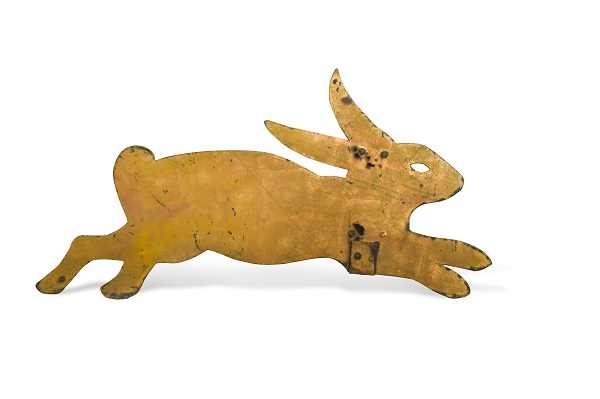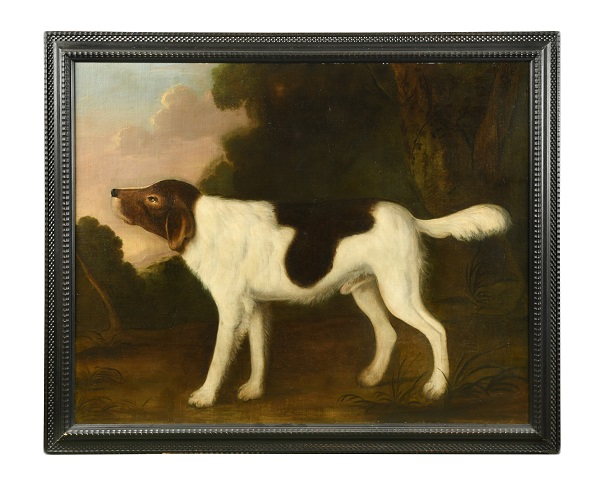Folk Art is probably one of the most uncategorised areas of the art world. Encompassing a range of items, from paintings to ceramics, fabric and even agricultural or kitchen implements, Folk Art is highly decorative and champions craftsmanship and heritage. Technically, there is no fixed definition for Folk Art. Rather it is works created by unknown artists, or those with no formal training, and is often characterised by pieces from the naïve school or pieces which are rooted in tradition. Usually identifiable by childlike or endearing imagery, the popularity of Folk Art appears to have been growing for around a decade, however, with today’s tastes for all things decorative and colourful, it appears to be more popular than ever.

A gilded iron hare silhouette weathervane and two painted metal bird decoys from the Handford Collection in Burford. Sold for £1,800 against an estimate of £100 - £200.
Technically Folk Art can be found the world over, with examples coming from every continent, and it continues to be created today by self-taught artists. Known as the ‘art of the people,’ it is gaining traction in both exhibitions but also at auction. The Tate Britain hosted an exhibition in 2014 which really celebrated British Folk Art and included paintings, shop signs, figureheads, Toby jugs and all kinds of unusual items which fall under the category. Often romantic, these pieces also encompass British sailors’ ‘woolies’ which were sewn scenes created from the 1840s onwards featuring ships and landscapes.
There is also a strong tradition of Folk Art from America. Usually, paintings from the early days of settlement, these pictures can be spotted by their naïve almost childlike imagery, as well as pottery, sculpture, textiles, wood and metalwork. We have found that several Folk Art pieces which have been offered at auction recently have sold directly to America, as the number of collectors across the pond grows.
The market for Folk Art has really flourished in recent years as collectors seek out its simple charms. For example, at The Fine Sale on 23rd March, we sold a Folk Art gilded iron hare silhouette weathervane and two painted metal bird decoys from the Handford Collection in Burford. This sold for a whopping £1,800 against an estimate of £100 - £200. Similarly, four painted wood decoy wood pigeons, again from the Handford Collection sold for £650 against an estimate of £100 - £200. These are the type of items which previously would have made very little at auction. They would have been sold at car boot sales or junk shops and struggled to have made even £100.

Four painted wood decoy wood pigeons, sold for £650 against an estimate of £100 - £200.
When it comes to paintings, Folk Art is often referred to as ‘Provincial’ or ‘Naïve’ School. Once you get to know the motifs of Folk Art, these can be easy to spot, perhaps the figures or animals are not anatomically correct, and could look like they have been painted by a child. They often come in maple frames and can achieve anything from the low hundreds to several thousands of pounds at auction.
The difficulty here for an auctioneer is finding the correct value. With known artists estimated values are easy to gauge, but Folk Art is all about the individual it appeals to. Often naïve paintings of pubs, or well-known places can be some of the most popular. For example, we sold a painting of The George Inn in Norton St Philip, Somerset for £360 last year. Whilst pictures showing animals, people or even still lifes can see significant competition. For example, a painting of an English Springer Spaniel from the English Provincial School, circa 1880, achieved £5,500 in 2022, whilst a 19th century Provincial School painting of a hare achieved £1,000 in 2020 against a £100 - £200 estimate.

Painting of an English Springer Spaniel from the English Provincial School, circa 1880, sold for £5,500.
For anyone looking to make their first foray into buying Folk Art, having a good root around antiques centres is always a good place to start, or seeking out items at regional auction houses. We tend to offer Folk Art in our regular Fine Sales, however there is sometimes the odd example which can crop up in the monthly Interiors Sales. As this is such a wide-ranging category, buying Folk Art must be a labour of love, rather than entered into from an investment standpoint. We would recommend that people buy the pieces which speak to them and will bring plenty of joy and colour to their homes. And if the market carries on as it has been, these pieces could be worth far more in a few years’ time.
To view the full calendar of sales at Cheffins, please click here.